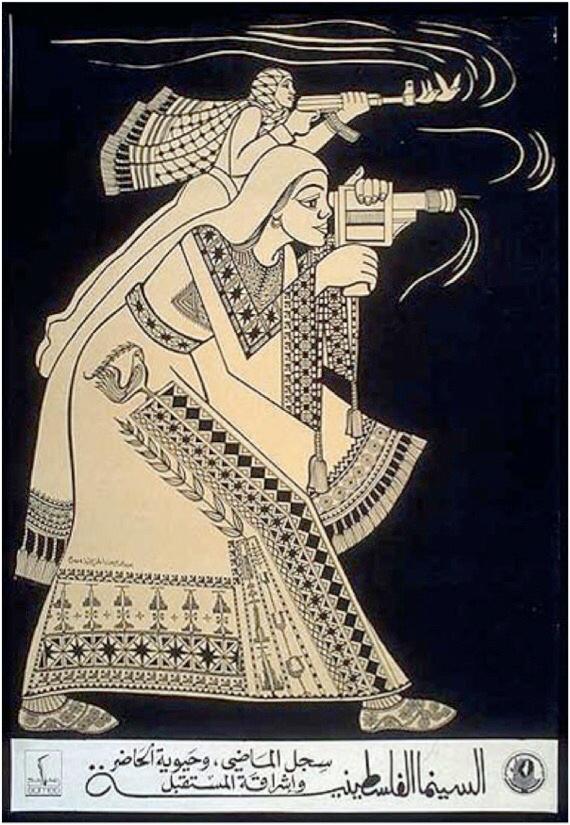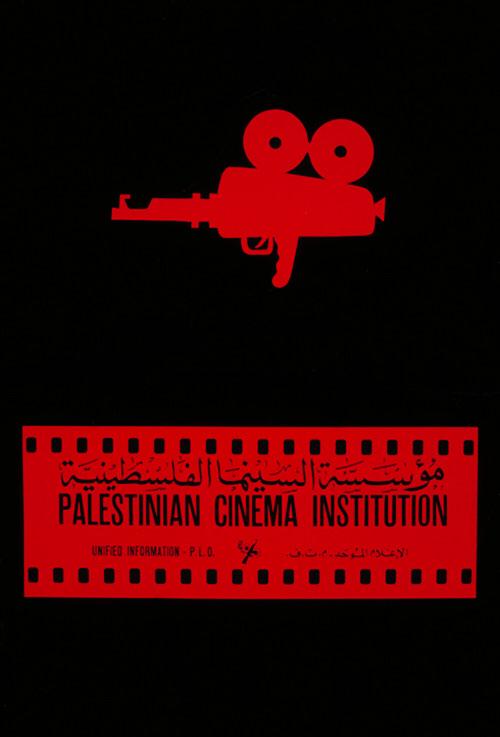

Introduction
In 1967, Palestinian photographers and filmmakers Salafa Jadallah, Mustapha Abu Ali, and Hani Jawhariyah came together in Amman to create the Photography Section in the Fatah Information Office and a year later started a film collective known as the Palestine Film Unit.[1]Rona Sela, “Seized in Beirut: The Plundered Archives of the Palestinian Cinema Institution and Cultural Arts Section,” Anthropology of the Middle East 12, no. 1 (Summer 2017): 89. After the Black September civil war that resulted in the expulsion of the PLO by the King Hussein regime, the Film Unit followed the PLO to Beirut.[2]Nadia Yaqub, Palestinian Cinema in the Days of Revolution (Austin: University of Texas Press, 2018), 64. The Film Unit, which eventually changed its name to the Palestinian Cinema Institution (PCI), made films until the Israeli Invasion in 1982, collaborating with non-Fatah political factions under the auspices of the short-lived Palestinian Cinema Group[3] Ibid, 66. as well as with foreign movements and governments like the Popular Front for the Liberation of Oman, the German Democratic Republic, and the Democratic Republic of Yemen.[4]Film Guide, Palestinian Cinema Institution, 1976, Constantine Zurayk Library, Institute for Palestine Studies, Beirut.
The film archive of the PCI disappeared after the invasion, with research by Rona Sela suggesting that it was plundered by Israeli forces and is stored in Israeli military archives.[5]Rona Sela, “The Genealogy of Colonial Plunder and Erasure – Israel's Control over Palestinian Archives,” Social Semiotics 28, no. 2 (2018): 201-229.
Despite the disappearance or destruction of the original archives, German filmmaker Monica Maurer, who collaborated with the PCI in the 1980s, and Palestinian artist Emily Jacir began work in 2013 to digitize film rushes from the 1977 documentary Tel al-Zaatar as well as digitize Maurer’s films to create an accessible archive documenting the revolutionary period of Palestinian film history.[6]Monica Maurer, interview by author, Skype, December 7, 2019. This preservation effort is conflated with the preservation of a radical politics that has been replaced by the neoliberal, negotiation-oriented outlook of the post-Oslo Palestinian leadership.
Tel al-Zaatar
In 1976, Mustapha Abu Ali began work on a film documenting the siege imposed by the right-wing militias of the Lebanese Front on the Tel Zaatar refugee camp located in the eastern outskirts of Beirut. Abu Ali collaborated with Lebanese filmmaker Jean Chamoun and Italian filmmaker Pino Adriano. After the bombing of Studio Baalbek, the filmmakers had no access to sound production equipment or a lab, so they had to search outside of Lebanon to complete post-production. It was through Adriano’s contacts with the Italian Communist Party that the filmmakers were able to access the production equipment of Unitelefilm, the communist production company. The filmmakers produced two versions of Tel al-Zaatar, one in Arabic and one in Italian. After the 1982 Israeli invasion and the plundering of the PCI archives, the Arabic version disappeared.
The disappearance of the Arabic version however, was not irreversible. The story of the resurrection of Tel al-Zaatar and the effort to digitize PCI films begins with the fate of the rushes of Tel al-Zaatar. Rushes are the raw, unedited visual and sound footage from filming. According to Maurer, rushes are usually disposed of after 3 years, but the Tel al-Zaatar rushes fortuitously survived. The 32 reels of film rushes were stored in the Italian Communist Party’s audiovisual archive, which was founded by the neorealist director Vittoria De Sica. In 1979, the rushes were transferred to the Archivio Audiovisio del Movimento Operaio e Democratico (AAMOD), a Rome-based archive dedicated to the preservation of audiovisual artifacts from labor and national liberation movements from around the world.
In 2013, AAMOD received an offer from the Italian State Archive to house the films in its newest building for audiovisual artifacts. Maurer, who collaborated with the PCI and is a member of the AAMOD board reached an agreement with the State Archive to ensure that it would be a “living archive” as she believed the footage must “be seen and made accessible.” Before being stored in the archive, Maurer and Jacir were allowed to digitize the rushes so they could be made available to the survivors of the Tel al-Zaatar massacre and the public. Jacir secured a grant from the Khalid Shoman Foundation in Amman to fund the project, and along with the artists' out-of-pocket funding, they both began the “Sisyphus feat” of digitizing the nearly 100 hours of footage.
It was through the digitization effort that the Arabic version of Tel al-Zaatar was able to be resurrected. Mauer and Jacir were able to use the rushes to restore and reconstitute the Arabic soundmix and dub the Italian version. The Arabic-audio version was recorded onto DVDs and given to the survivors of the Tel al-Zaatar massacre. Independently, survivors are themselves engaged in an effort to construct an audiovisual archive which includes the sharing of photographs on survivor Facebook groups like Mukhayyam al-Sumud al-Usturi Tel al-Zaatar (Camp of Legendary Steadfastness, Tel al-Zaatar) and Rabitat Ahali Mukhayyam Tel al-Zaatar (Association of Residents of Tel al-Zaatar).[7] Nadia Yaqub, Palestinian Cinema in the Days of Revolution), 182-191.
Maurer recorded the footage from the rushes and the Arabic-audio Tel al-Zaatar onto hard drives along with digitized recordings of the films she made with the Palestinian Red Crescent and PCI filmmaker Samir Nimr. The digitized films include Why, The Fifth War (narrated by Vanessa Redgrave), Children of Palestine, Born out of Death, Amman, al-Fatah, Saloon al-Fidah, Nakba, Gaza Hospital, and Encounters. Hard drives were given to the Institute of Palestine Studies libraries in Beirut and Ramallah on the condition that the films be made readily available to the public.
Preserving the Revolution
The effort to preserve the films is inscribed with great significance by the press and the people responsible for the digitization, Maurer and Jacir. Press coverage helped conflate preservation of the films with resistance to occupation. Al-Jazeera described the digitization effort as the preservation of the Palestinian collective[8]Tawfiq Abed, “Tel az-za’tar...wathaiqi yoarrikh li majzarat al-mukhayyam al-filistini” [“Tel al-Zaatar...Documentary Recording History of Massacre of Palestinian Camp”], Al-Jazeera, Feb. … Continue reading memory while the London-based, Palestinian-owned Al-Quds Al-Arabi newspaper described the eradication of Palestinian memory as an Israeli goal.[9]Zahra Merhi, “Al-mukhrja al-alamaniya monica maurer ta’ml a’la raqmanat 100 sa’a min ath-thakra as-sinimaiya al-filistiniya” [“German Director Monica Maurer Working on Digitizing 100 … Continue reading Journalists may have had their own ideas on what the preservation meant, however they may also have been influenced by the meaning ascribed to the project by Jacir and Maurer. Jacir told The Jordan Times that the preservation came at a time when her “community’s history is slowly being wiped out and erased” and that she felt it was important to document both the moment in cinematic history as well as the details of the Tel al-Zaatar massacre.[10]Hind Joucka, “Four Decades After Filming, Tel Al Zaatar Documentary Screened in Jordan for First Time,” The Jordan Times, Feb. 12, 2015, … Continue reading Maurer told The Electronic Intifada that the films document “social structures...political structures” from a time of “compassion and participation of all the people” that is unimaginable today.[11]Maureen Clare Murphy, “1970s Film of Palestinian Struggle in Lebanon Restored,” The Electronic Intifada, Nov. 17, 2013, … Continue reading
During a conversation I had with Maurer, she described the preservation as an archive to an internationalist political project of solidarity and resistance to capitalist imperialism that has been replaced by neoliberalism. PCI films do not just provide a historical record of that period in history when support for leftism and Palestinian national liberation was the preponderant ideology, but the films themselves were physical products of radically different political economy. While PCI eventually began using Studio Baalbek facilities, most laboratory work and printing was done in the cinema section of the Palestine Martyrs Works Society or SAMED, a vocational training program[12]Cheryl A. Rugenberg, “The Civilian Infrastructure of the Palestine Liberation Organization”: 69. Initially created to provide assistance to the families of fallen fedayeen, the scope of SAMED expanded to include communally-owned industrial and agricultural projects designed to achieve Palestinian self-sufficiency. The physical production of the films was rooted in a leftist economic project that has since disappeared from the post-Oslo political landscape.
Making the films accessible to younger generations is meant to provide a political vision that is an alternative to the one adopted by the Palestinian Authority which has replaced the PLO. Rather than promoting negotiations, concessions, and cooperation with Israel and America, the PCI films took a clear stance in favor of armed resistance to both Zionism and American imperialism. While Palestinian refugees living in the diaspora have been sidelined by Oslo and other agreements that focus exclusively on the fate of Palestinians living in the occupied territories, the refugee camps of countries surrounding Palestine had previously been the sites of the militant organizing of a government-in-exile.
The films also document a time when the status of Palestinians in Lebanon was much different. As refugees, Palestinians have always been marginalized in Lebanon; however, the Palestinian question used to be the central issue of leftists and Arab nationalists, with Yasser Arafat openly being courted by Kamal Joumblatt and George Hawi. After the withdrawal of PLO fighters from Lebanon to Tunisia in 1982, residents of camps were subjected to sieges and massacres by both Israeli and Syrian militia proxy forces including Kataeb’s notorious Sabra and Shatilla massacre and Amal’s three-year siege known as the War of the Camps. Palestinians have become pawns in cynical attempts on the part of chauvinist Lebanese political parties to posture strength. From the 2007 campaign in Nahr el-Barad Camp when the Lebanese Army “proved” its strength by displacing 30,000 residents to the 2019 campaign by the Lebanese Forces Labor Minister against Palestinian workers classified as “illegal laborers,” Palestinians and the camps are opportunitites for the weak Lebanese state to flex its muscles.
Questions of Access
The film rushes of Tel al-Zaatar are now housed in the Italian state audiovisual archives. While physical access requires travel to Rome, the digitized footage has been shared with the public, specifically the Palestinian community, through the distribution of DVDs to Tel al-Zaatar survivors and to the Beirut and Ramallah branches of the Institute of Palestine Studies. The libraries of a private institution were chosen because there is no central Palestinian archive. Israeli looting, the fractious political environment of Palestine, and economic precariousness have left Palestinian historical artifacts scattered in Israeli archives, private universities, and the offices of Palestinian political factions.
While I was able to easily access the films with the assistance of the staff at the Constantine Zurayk library in Beirut, the films are inaccessible to the public in Ramallah. Despite agreeing to give the public access to the films, Maurer informed me that she discovered that the Ramallah branch was not allowing people to view the films, using the excuse that they had no technical equipment. The films were then transferred to the offices of the Palestinian Broadcasting Corporation (PBC) which has an archive unit. However, Maurer has learned that the PBC archive is also not allowing the public to access the films. It is not clear why PBC is restricting access, though Maurer attributes it to a combination of incompetence and the current political situation. The PBC is controlled by the Palestinian Authority (PA), the Israeli-sanctioned quasi-state body that coordinates with Israeli security forces which may prefer to restrict access to films that Israeli authorities may consider to promote violent incitement against them.
While the aspirations of Maurer and Jacir to create an archive to preserve Palestinian cinematic, political, and social history is admirable, the inaccessibility of the films for residents of Palestine draws into question the extent to which the digitization project will impact Palestinian memory. Digitization was meant to solve the problem of the films’ physical storage in Rome, but access to the films is limited to Beirut. Asserting the ability to preserve revolutionary politics through digitization of media is even more untenable when the digitized films are made inaccessible in Palestine by a bureaucracy controlled by the PA. While emphasis is placed on professional archives of state and academic institutions, YouTube may be the most accessible platform for PCI films.[13]Palestinian Cinema Archive, Youtube channel, https://www.youtube.com/channel/UCsvO5Jo-ADsfiHFCNoykrSA/videos Whether the goal is to preserve artifacts of media history or to promote a return to an abandoned political project, archivists must grapple with the way geography, politics, and travel restrictions affect the mission of the archive.
Conclusion
Filmmakers from the PCI brought a Third Cinema perspective to Palestine by deciding that “aesthetic may be sacrificed for the sake of political instrumentalism” so that “instrumentalism itself is transformed into the aesthetic.”[14]Joseph Massad,“The Weapon of Culture,” 31. This revolutionary perspective was reflected in the films’ promulgation of the idea of armed struggle and their critique of Zionism, imperialism, and capitalism. This style was adopted in part as a deference to the tastes of the residents of camps who were consulted during the filmmaking process.[15] Ibid, 34. The community-oriented approach was also reflected in the post-production work that was primarily done in the laboratories and printing studios of self-sufficiency-oriented SAMED. As most of the films were documentaries, they are historical records of military operations against Israeli and right-wing Lebanese forces as well as daily life in the camps during the heyday of Palestinian leftism. The world that is recorded in the PCI films, in their content and physical production seems distant, with the strategy of liberating Palestine militarily being replaced by negotiations and socialism giving way to neoliberalism. Efforts to preserve the films are not just motivated by the desire to archive, as the preservationists articulate a desire to provide an alternative political vision to the status quo.
Thomas Keppen
Thomas Keppen is a graduate student at The Center for Arab and Middle Eastern Studies at the American University of Beirut. His thesis research focuses on newspaper coverage of the 1973 Tobacco Farmer Uprising in Nabatieh.
Footnotes:
| ↑1 | Rona Sela, “Seized in Beirut: The Plundered Archives of the Palestinian Cinema Institution and Cultural Arts Section,” Anthropology of the Middle East 12, no. 1 (Summer 2017): 89. |
|---|---|
| ↑2 | Nadia Yaqub, Palestinian Cinema in the Days of Revolution (Austin: University of Texas Press, 2018), 64. |
| ↑3 | Ibid, 66. |
| ↑4 | Film Guide, Palestinian Cinema Institution, 1976, Constantine Zurayk Library, Institute for Palestine Studies, Beirut. |
| ↑5 | Rona Sela, “The Genealogy of Colonial Plunder and Erasure – Israel's Control over Palestinian Archives,” Social Semiotics 28, no. 2 (2018): 201-229. |
| ↑6 | Monica Maurer, interview by author, Skype, December 7, 2019. |
| ↑7 | Nadia Yaqub, Palestinian Cinema in the Days of Revolution), 182-191. |
| ↑8 | Tawfiq Abed, “Tel az-za’tar...wathaiqi yoarrikh li majzarat al-mukhayyam al-filistini” [“Tel al-Zaatar...Documentary Recording History of Massacre of Palestinian Camp”], Al-Jazeera, Feb. 11, 2015, https://www.aljazeera.net/news/cultureandart/2015/2/11/-%D8%AA%D9%84-%D8%A7%D9%84%D8%B2%D8%B9%D8%AA%D8%B1-%D9%88%D8%AB%D8%A7%D8%A6%D9%82%D9%8A-%D9%8A%D8%A4%D8%B1%D8%AE-%D9%84%D9%85%D8%AC%D8%B2%D8%B1%D8%A9-%D8%A7%D9%84%D9%85%D8%AE%D9%8A%D9%85-%D8%A7%D9%84%D9%81%D9%84%D8%B3%D8%B7%D9%8A%D9%86%D9%8A |
| ↑9 | Zahra Merhi, “Al-mukhrja al-alamaniya monica maurer ta’ml a’la raqmanat 100 sa’a min ath-thakra as-sinimaiya al-filistiniya” [“German Director Monica Maurer Working on Digitizing 100 Hours of Palestinian Cinematic Memory”], Al-Quds Al-Arabi, May 20, 2017, https://www.alquds.co.uk/%ef%bb%bf%d8%a8%d8%b9%d8%af-40-%d8%b3%d9%86%d8%a9-%d9%85%d9%86-%d8%aa%d8%b5%d9%88%d9%8a%d8%b1%d9%87%d8%a7-%d9%84%d9%84%d8%ab%d9%88%d8%b1%d8%a9-%d8%a7%d9%84%d9%81%d9%84%d8%b3%d8%b7%d9%8a%d9%86%d9%8a/ |
| ↑10 | Hind Joucka, “Four Decades After Filming, Tel Al Zaatar Documentary Screened in Jordan for First Time,” The Jordan Times, Feb. 12, 2015, http://www.jordantimes.com/news/local/four-decades-after-filming-tel-al-zaatar-documentary-screened-first-time-jordan |
| ↑11 | Maureen Clare Murphy, “1970s Film of Palestinian Struggle in Lebanon Restored,” The Electronic Intifada, Nov. 17, 2013, https://electronicintifada.net/content/1970s-film-palestinian-struggle-lebanon-restored/12914 |
| ↑12 | Cheryl A. Rugenberg, “The Civilian Infrastructure of the Palestine Liberation Organization”: 69 |
| ↑13 | Palestinian Cinema Archive, Youtube channel, https://www.youtube.com/channel/UCsvO5Jo-ADsfiHFCNoykrSA/videos |
| ↑14 | Joseph Massad,“The Weapon of Culture,” 31. |
| ↑15 | Ibid, 34. |



